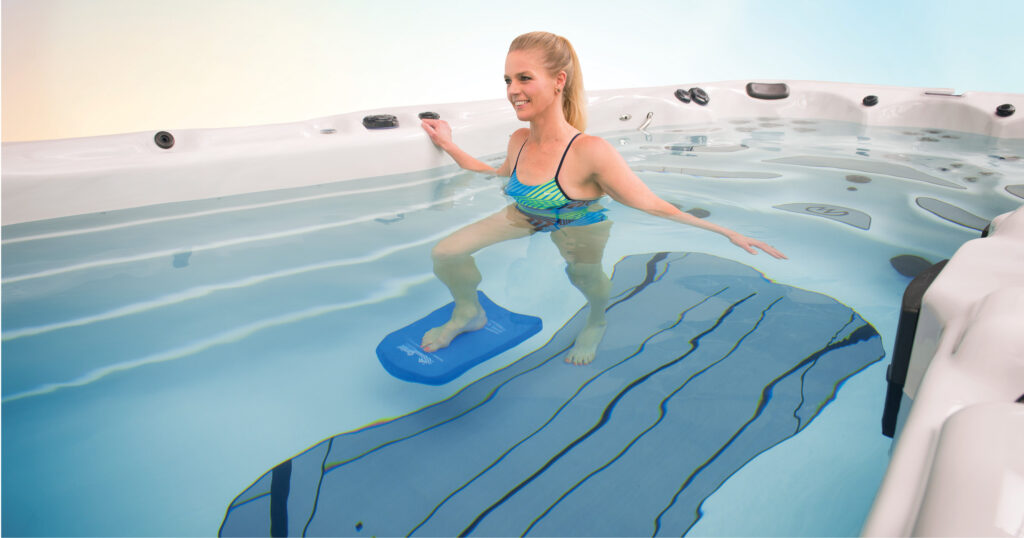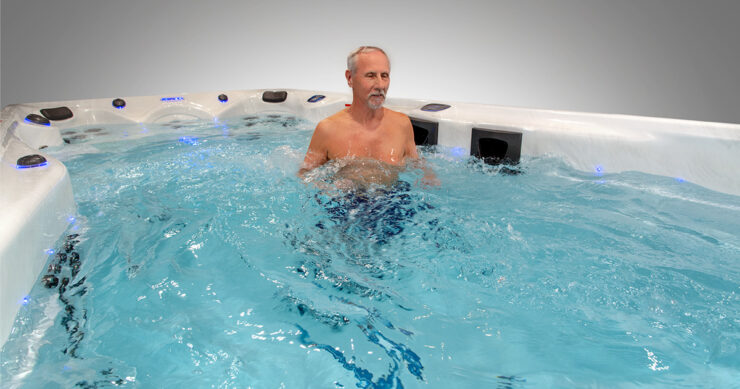Exercise is an important component of any healthy lifestyle. But for people living with Parkinson’s Disease, regular movement can play a key role in a holistic treatment plan.
As a chronic and progressive neurodegenerative disorder, people with Parkinson’s experience a range of symptoms including tremors, rigidity, slowed movement, and postural instability. It affects about a million Americans and nearly 90,000 people are diagnosed each year.
Exercise offers myriad benefits for those people, whether they are newly diagnosed or have been living with the disease for years. Research shows that physical activity can improve symptoms and potentially even slow the progression of the disease.
Water exercise has been shown to be particularly therapeutic. Whether it’s swimming in a swim spa, taking an aqua aerobics class, or just enjoying the buoyancy of the water, aquatic exercise can help people with Parkinson’s manage symptoms, alleviate stress, and improve their overall quality of life.

Exercising and Parkinson’s
From dopamine-based therapies to deep brain stimulation, advancement in Parkinson’s treatment has allowed people with the disease to see improvement in symptoms.
However, medications don’t necessarily halt the progression of the disease.
From improving motor function to preserving cognitive function, physical activity can not only manage symptoms but potentially slow the progression of the disease [source]. Incorporating exercise into an overall treatment plan can offer a multifaceted approach to managing Parkinson’s.
Improved motor function
Parkinson’s primarily affects the brain’s dopamine-producing neurons, leading to motor impairments. People often experience tremors, stiffness, slow movement, and muscle cramps. In addition, they might struggle with balance and dizziness — which can increase their fall risk.
Exercise, though, can help improve these symptoms.
A meta analysis published in the Frontiers in Aging Neuroscience Exercise found that exercise, including aqua therapy, can slow the progression of these symptoms while improving mobility and helping with balance. In addition, regular exercise can also improve gait, which can help people with Parkinson’s move more freely and independently.
Neuroprotective effects
When we think about the advantages of exercise, our minds often gravitate towards the physical benefits — improving cardiovascular health, increasing strength, or maintaining overall fitness. However, the benefits of purposeful movement extend far beyond just getting your heart pumping; there’s also a profound impact on brain health.
And those physiological and biochemical changes in the brain are particularly beneficial for people with Parkinson’s.
Emerging research suggests that exercise may exert neuroprotective effects in Parkinson’s. Physical activity stimulates the release of neurotrophic factors, compounds that support the growth and survival of neurons. By promoting neuroplasticity — the brain’s ability to adapt and reorganize — exercise may help to slow the progression of Parkinson’s and preserve cognitive function.
Improved mood
Living with a chronic illness like Parkinson’s can take a toll on mental health, leading to depression, anxiety, and social isolation. Data state that at least 50 percent of people with Parkinson’s will experience some form of depression and up to 40 percent will experience an anxiety disorder.
Exercise acts as a natural mood enhancer, triggering the release of endorphins — those feel-good chemicals that alleviate stress and promote a sense of well-being. Additionally, participating in group exercise classes fosters social connections, reducing feelings of loneliness and fostering a sense of community.
Enhanced quality of life
Ultimately, the cumulative impact of exercise on physical, cognitive, and emotional well-being translates into a higher quality of life for individuals with Parkinson’s. By empowering patients to actively manage their symptoms and engage in life-affirming activities, exercise offers a sense of agency and control in the face of a daunting diagnosis.

Benefits of water exercise for people with Parkinson’s Disease
When it comes to exercise for Parkinson’s, there’s no one-size-fits-all approach. The key is to find activities that align with individual preferences, abilities, and goals. From tai chi and yoga to cycling and swimming, there’s a diverse array of exercise modalities suitable for people with Parkinson’s.
Water exercise has been shown to be particularly beneficial, with the water offering a comfortable and soothing environment for movement. From improved mobility and motor control to increased muscle strength, flexibility, and cardiovascular health, water exercise provides a holistic approach to managing the symptoms of Parkinson’s. The cognitive engagement and mental well-being benefits offer further benefits.
Enhanced mobility and motor control
One of the primary impairments faced by Parkinson’s patients is a decline in mobility and motor control. In advanced stages, people may experience severe stiffness and slow movements and might not be able to walk.
One of water’s natural properties, buoyancy, creates a supportive movement for exercise. It can reduce stress on the joints while offering a supportive environment. When exercising in water that’s chest deep, that pressure is reduced by about 80 percent.
Research shows that hydrotherapy, including swimming, water walking, and aquatic aerobics, can improve gait and balance control in Parkinson’s patients. The reduced impact of water reduces the risk of falls, allowing individuals to practice and improve coordination, posture, and stability.
Michael Phelps Signature Swim Spas offer an intimidation-free space for water exercise. For people who are fearful of falling, they can hold onto the side of the spa while performing therapeutic water exercises. In addition, the nonslip comfort flooring system offers a unique combination of grip and traction, giving people the confidence that they can exercise safely.
Increased muscle strength and flexibility
As Parkinson’s disease progresses, individuals often experience muscle weakness and rigidity.
Water provides a natural resistance that increases muscle strength and endurance. Scientific studies have demonstrated that water-based resistance training programs significantly improved muscle flexibility, reducing joint stiffness and enhancing overall movement patterns.
Michael Phelps swim spas offer a generous space for water exercise. With the adjustable swim current, owners can customize the intensity of their resistance training to suit their fitness level and goals. People can water walk, aqua jog, or swim against the current. But people can also use aquatic exercise equipment, such as dumbbells or the rowing bars, to do strength specific exercises.
In addition, swim spa owners can adjust the water temperature, up to 99 degrees in the swim area, allowing them to tailor their aquatic experience to their preferences. Exercising in warm water can help relax muscles, increase blood flow, and reduce stiffness, making it easier to move and stretch. This enhanced flexibility allows for a wider range of motion during exercises, promoting better joint mobility and reducing the risk of injury — which is particularly beneficial for people with Parkinson’s Disease.
Improved cardiovascular health
Regular aerobic exercise is crucial for maintaining cardiovascular health in individuals with Parkinson’s disease. Water exercise in a swim spa not only provides an accessible and safe environment but also offers cardiovascular benefits.
Aerobic water activities such as swimming and water walking effectively raise the heart rate, promoting cardiovascular fitness. The hydrostatic pressure of water provides additional resistance, adding another challenge for the heart and lungs. These activities help strengthen the cardiovascular system, reducing the risk of cardiovascular diseases often associated with the sedentary lifestyle commonly observed in Parkinson’s patients.
Cognitive engagement and mental well-being
Exercise’s impact on cognitive function and psychological well-being is well-documented, and water exercise is no exception. Research suggests that water-based exercise can have profound positive effects on cognition in individuals with Parkinson’s disease.
Studies have found that aquatic exercises boost the release of endorphins, neurotransmitters responsible for regulating mood and reducing pain sensation. Furthermore, exercising in water engages multiple sensory systems, including tactile, visual, and auditory, enhancing cognitive stimulation.
Water exercise also offers a conducive social environment, promoting interaction amongst participants, reducing feelings of isolation, and improving overall mental well-being.

How to buy a Michael Phelps swim spa
Are you ready to invest in one of these top swim spas for 2024? A Michael Phelps Signature Swim Spa is an all-season pool alternative that you can use not just this year but for many years to come. You can click here to learn about how you create a backyard oasis with a Michael Phelps Signature Swim Spa. Or, contact your local Master Spas retailer to learn more about swim spa ownership. Wondering how much a Michael Phelps swim spa costs? You can request a quote here.

